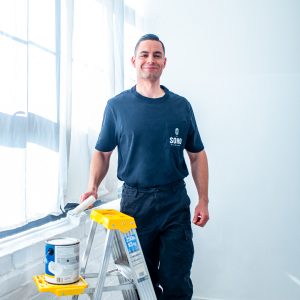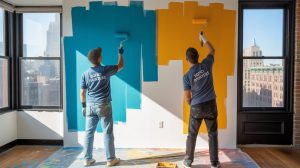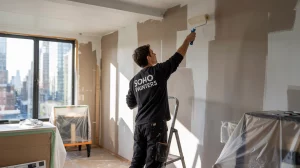Living in New York City often means making the most of every square foot, and we’ve seen countless clients transform their cramped spaces into stylish, functional homes using one simple technique: color blocking. At Soho Painters, we’ve helped hundreds of NYC residents discover how strategic paint placement can visually expand their apartments without knocking down walls or spending thousands on renovations.
Color blocking isn’t just an artistic trend—it’s a practical design strategy that uses contrasting or complementary colors to define spaces, create visual interest, and manipulate how our eyes perceive room dimensions. In tiny NYC apartments where every inch counts, this technique becomes especially powerful because it works with your existing layout rather than against it.
The beauty of color blocking lies in its versatility and affordability. Whether you’re dealing with a studio apartment in the East Village or a one-bedroom in Brooklyn, you can use paint to create distinct zones, make ceilings appear higher, and give your space a custom, designer feel. We’ve watched clients completely transform their living experience simply by understanding how to use color strategically, and the results consistently exceed expectations.
Understanding Color Blocking in Small Spaces
Color blocking involves using distinct blocks or sections of color to create visual boundaries and focal points within a room. Unlike traditional painting where walls are typically one uniform color, this technique deliberately contrasts different hues, tones, or shades to achieve specific visual effects.
In NYC apartments, where open floor plans and studio layouts dominate the rental market, color blocking becomes an invaluable tool for creating structure and definition. The technique works by training your eye to see separate areas within one continuous space, effectively “building” walls where none exist physically.
The psychology behind this approach is rooted in how our brains process visual information. When we see distinct color changes, our minds naturally interpret these as boundaries or transitions between spaces. This perception tricks the eye into seeing multiple rooms instead of one cramped area, making your apartment feel more organized and spacious.
What makes color blocking particularly effective in NYC apartments is the abundance of natural light many buildings receive, especially in Manhattan and areas of Brooklyn with good exposure. This natural light interacts with painted surfaces throughout the day, creating dynamic color experiences that enhance the blocking effect and prevent spaces from feeling flat or monotonous.
Best Color Choices for NYC Apartments
Selecting the right colors for your blocking strategy can make or break the effectiveness of this technique. Light and bright tones remain the foundation of successful small-space color blocking because they reflect light and create an airy, open feeling that’s essential in cramped quarters.
Soft whites, cream tones, and pale grays work exceptionally well as base colors because they provide a neutral backdrop that makes other colors pop while maintaining that crucial sense of spaciousness. We’ve found that warm whites with subtle undertones create more inviting spaces than stark, cool whites, which can feel sterile in small NYC apartments.
For accent blocks, dusty blues and muted lavenders offer sophisticated contrast without overwhelming the space. These colors have enough personality to define zones while remaining subtle enough to live with daily. Sage greens and soft terracottas also work beautifully, especially in apartments with good natural light exposure.
The strategic use of one darker or moody accent wall can add dramatic flair without compromising the overall sense of space. Deep navy, charcoal, or even black can work when applied to shorter walls or specific zones like behind a bed or desk area. The key is ensuring that how long paint lasts in high-contrast applications, as darker colors tend to show wear more readily.
Consider your apartment’s lighting when making color choices. North-facing units receive cooler light that can make warm colors appear muted, while south-facing apartments get intense light that might wash out pale colors. Understanding these nuances helps ensure your color blocking looks intentional and polished rather than accidental.
Vertical vs. Horizontal Color Blocking Techniques
The direction of your color blocks dramatically impacts how your space feels and functions. Vertical color blocking involves painting from floor to a specific height—typically two-thirds up the wall—which draws the eye upward and creates the illusion of higher ceilings. This technique is particularly valuable in NYC apartments where ceiling height is often limited.
When implementing vertical blocking, we recommend using lighter colors on the upper portion and slightly deeper or more saturated tones below. This creates a grounding effect while maintaining the upward visual pull. The transition line doesn’t need to be perfectly straight—a slightly organic edge can feel more relaxed and forgiving if you’re doing the work yourself.
Horizontal color blocking works differently, creating visual width and helping define separate functional areas within the same room. This technique involves painting horizontal bands or sections that correspond to different uses—perhaps a calmer tone behind your sleeping area and a more energizing color in your work zone.
The success of horizontal blocking depends heavily on proportion and placement. Generally, avoid cutting rooms exactly in half horizontally, as this can make spaces feel choppy. Instead, use the golden ratio or divide spaces into thirds for more pleasing proportions.
Both techniques benefit from understanding whether you need primer before painting walls, especially when transitioning between dramatically different colors or covering existing paint. Proper preparation ensures clean lines and professional-looking results that enhance rather than detract from your space.
Creating Functional Zones with Color
One of the most practical applications of color blocking in NYC apartments is zone creation—using paint to designate specific areas for different activities without physical barriers that would make small spaces feel even more cramped.
For bedroom areas in studio apartments, painting a soft-toned rectangle or geometric shape behind your bed creates an instant headboard effect while psychologically separating your sleep space from the rest of the room. Colors like pale blush, soft gray, or muted sage work particularly well for this application because they’re calming yet distinct enough to define the space clearly.
Work areas benefit from slightly more energizing colors that promote focus and productivity. A gentle blue or green accent wall behind your desk can help your brain shift into work mode while maintaining the overall flow of your apartment. The key is choosing colors that complement rather than clash with your primary palette.
Kitchen and dining areas, even when they’re just a corner with a small table, can feel more intentional with thoughtful color placement. Consider matching wall colors with wood floors to create cohesive flow while still defining separate zones through strategic accent placement.
Living areas typically work best with the most neutral tones in your palette, as these spaces need to feel relaxing and versatile for various activities. However, a carefully placed accent wall or color block can add personality without overwhelming the multi-functional nature of these areas.
Storage and utility areas, while often overlooked, can benefit from color blocking too. A different tone behind floating shelves or in alcoves can make these practical elements feel more integrated and intentional rather than afterthoughts.
The magic happens when all these zones work together harmoniously while maintaining their individual identity. This is where understanding how painting changes a room becomes crucial—each color choice affects not just its immediate area but the overall feel and flow of your entire apartment.
Ready to Transform Your NYC Apartment?
Color blocking offers an affordable, renter-friendly way to make your small NYC apartment feel larger, more organized, and uniquely yours. The technique requires planning and precision, but the results can completely transform how you experience your living space.
At Soho Painters, we specialize in helping NYC residents maximize their small spaces through strategic color choices and expert application. Whether you’re looking for apartment painting services, need help with interior painting planning, or want professional commercial painting for your office space, our team understands the unique challenges of NYC living.
Ready to see what color blocking can do for your space? Contact us today for a consultation, and let’s discuss how we can help you create the perfect color strategy for your NYC apartment.





